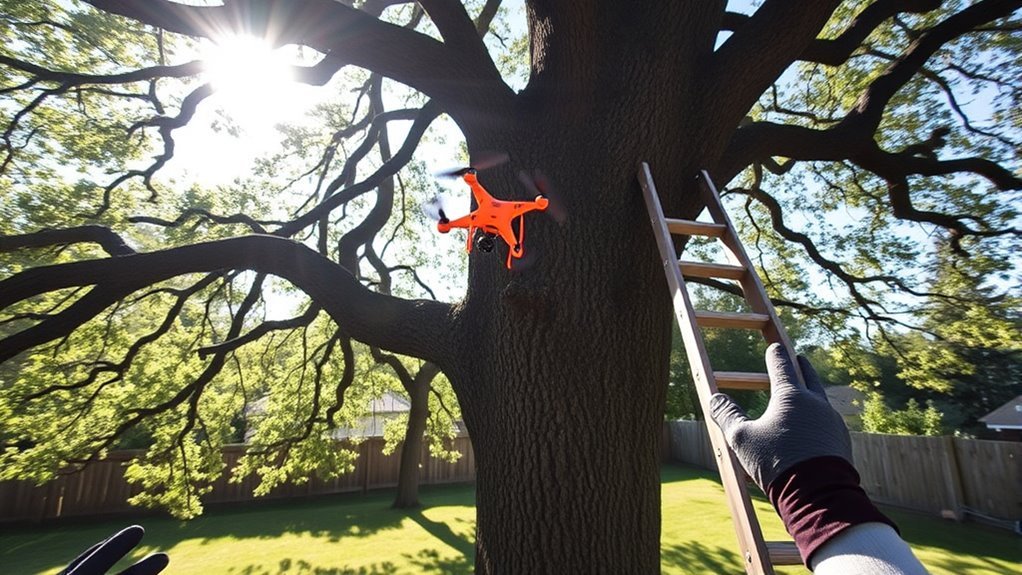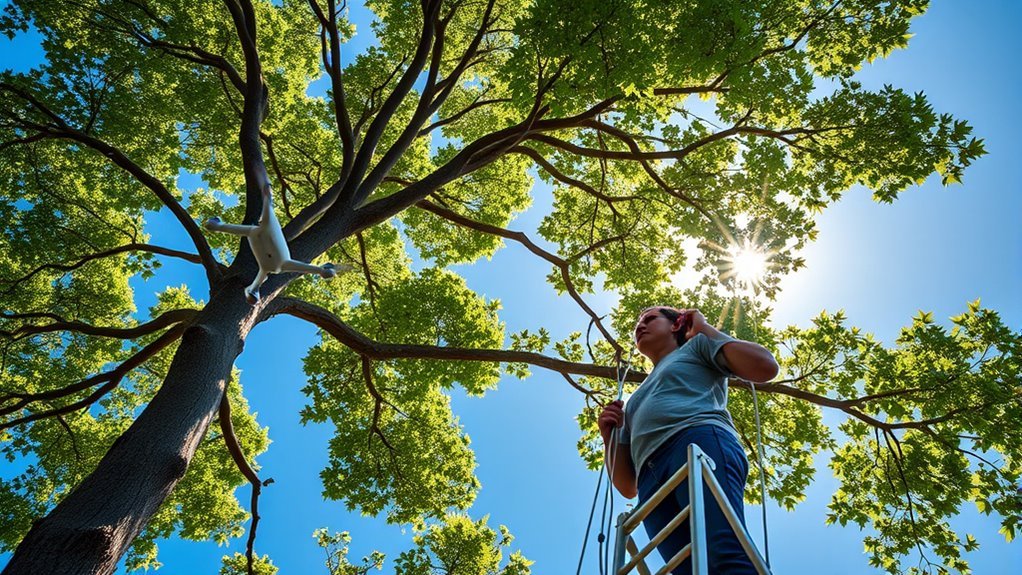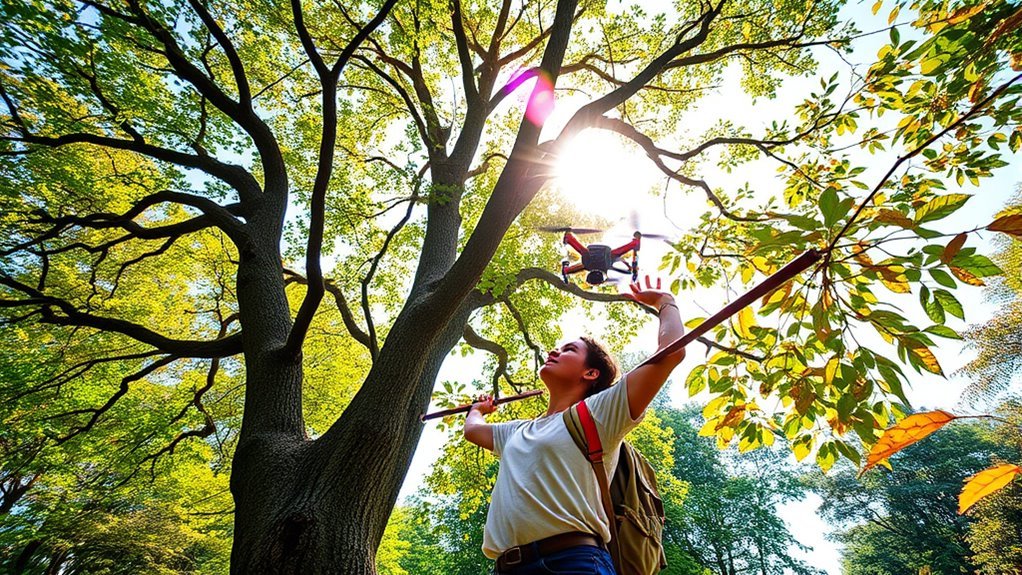If your drone’s stuck in a tree, start by evaluating the situation to gauge height and potential hazards. Next, gather the right tools, like an extendable pole and rope. Create a clear retrieval plan, considering your climbing methods and safety gear. Execute your plan carefully, maintaining balance while retrieving the drone. Finally, prevent future mishaps with regular maintenance and smart flying practices. Stick around for more tips on ensuring your drone stays safe in the skies.
Assess the Situation

Before attempting to retrieve your drone, it’s vital to assess the situation. First, determine the tree height—knowing how high your drone is lodged will influence your recovery strategy. If it’s a tall tree, consider your physical limitations and available resources. Next, identify the drone type; different models have varying weights and structural integrity that could affect how you approach the retrieval. For instance, a lightweight drone may be easier to dislodge than a heavier model. Also, check the surrounding environment for hazards like power lines or unstable branches. This assessment provides significant insights, ensuring you can act safely and effectively, enhancing your chances of freeing your drone without causing damage to it or the tree.
Gather Your Tools

Once you’ve assessed the situation, it’s time to gather your tools. Having the right equipment is vital for guaranteeing drone safety and effectively retrieving your drone from various tree types. Here’s a list of essential tools you might need:
| Tool | Purpose |
|---|---|
| Extendable pole | To reach high branches safely |
| Rope | For retrieval or securing tools |
| Soft padding | To protect the drone during retrieval |
| Gloves | To maintain grip and safety |
With these tools in hand, you can approach the tree with confidence. Remember, different tree types may require specific techniques, so stay adaptable and cautious as you proceed. Your drone’s safety depends on your preparation.
Create a Retrieval Plan

As you prepare to retrieve your drone, creating a detailed plan is essential for a successful recovery. Start by evaluating the tree’s height and the drone’s position. Identify safe tree climbing techniques, ensuring you have a reliable method to reach your drone without risking injury. Consider using a harness or climbing gear to enhance drone safety during the operation. Make a checklist of tools you’ll need, like a long pole or a retrieval hook. Plan for potential obstacles, such as branches or power lines. Communicate with a friend to assist you in case of emergencies. Finally, set a timeline to keep your retrieval efforts focused and efficient, allowing you to reclaim your drone with minimal risk.
Execute the Plan
While you may feel anxious about retrieving your drone, executing your plan methodically will greatly increase your chances of success. Begin by evaluating the tree’s height and branch structure. Confirm you’ve got the right gear for tree climbing and that you’re following drone safety protocols.
| Step | Action |
|---|---|
| Gear Check | Inspect climbing equipment |
| Approach | Position yourself safely |
| Retrieval | Carefully climb and retrieve |
| Exit Strategy | Descend safely and securely |
Focus on maintaining balance and control while climbing. Avoid sudden movements that could cause accidents. By adhering to your plan, you not only enhance your chances of a successful retrieval but also confirm your safety throughout the process.
Prevent Future Incidents
To prevent future incidents where your drone might get stuck in a tree, it is vital to understand the factors that contribute to such situations. Regular drone maintenance is essential; verify your propellers are in top shape and your battery is fully charged before each flight. Familiarize yourself with your drone’s capabilities and limitations, particularly in windy conditions or around tall structures. Weather conditions can significantly affect your drone’s stability, so prioritize flight safety by avoiding densely wooded areas and practicing in open spaces to enhance your piloting skills. Using GPS and altitude settings can help maintain control, reducing the risk of collisions. Additionally, be aware that battery capacity directly limits flight time and travel distance, so plan your flights accordingly. By adopting these strategies, you’ll not only enjoy the freedom of flying but also minimize the chances of your drone becoming ensnared in trees.
Frequently Asked Questions
Can I Use a Ladder to Retrieve My Drone From a Tree?
Sure, you can use a ladder for drone retrieval, but ladder safety’s essential. Without proper precautions, you might feel like a circus acrobat! Always confirm stability and take necessary measures to avoid accidents.
What Should I Do if My Drone Is Damaged?
If your drone’s damaged, assess the extent first. You’ve got repair options like DIY fixes or professional services. If it’s severe, consider filing an insurance claim to cover costs and get back in the air quickly.
Are There Specific Tools Recommended for Tree Retrieval?
Ever felt the frustration of a drone stuck in a tree? For effective drone retrieval, consider using specialized drone retrieval tools and tree climbing gear like ropes or harnesses to safely recover your device without damage.
How Can I Safely Climb a Tree to Get My Drone?
To safely climb a tree for your drone, use proper tree climbing techniques—like three points of contact—and always wear a harness. Prioritize safety precautions, ensuring you’re aware of your surroundings and any potential hazards.
Is It Legal to Retrieve My Drone From Someone Else’s Tree?
It’s vital to understand property laws regarding drone ownership rights. Retrieving your drone from someone else’s tree might require permission, as trespassing could lead to legal complications. Always seek consent before attempting recovery.

